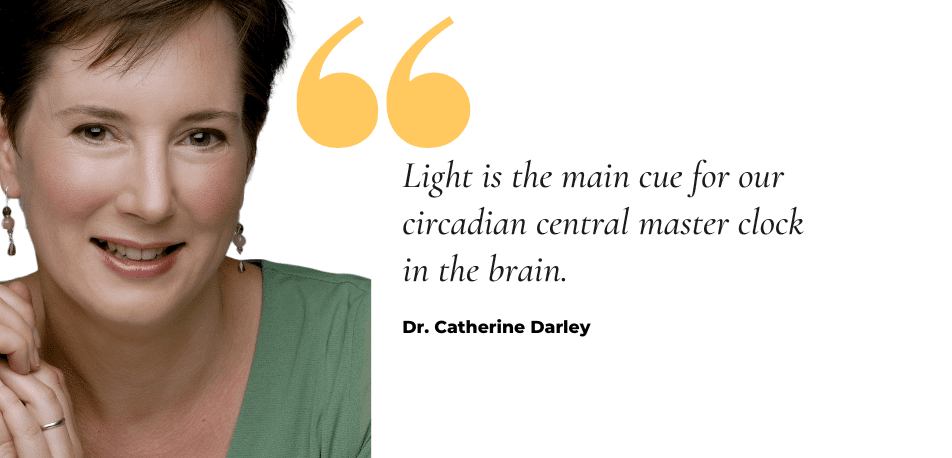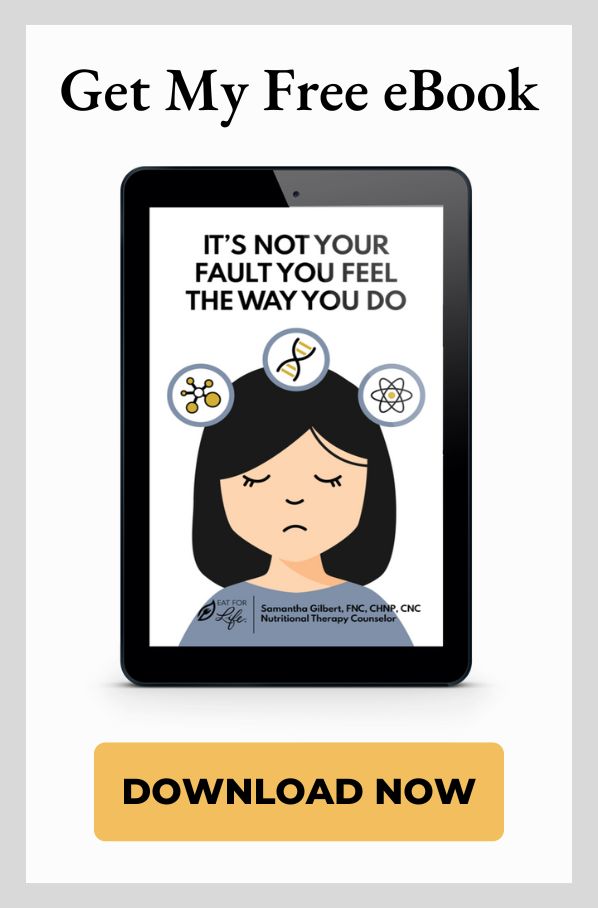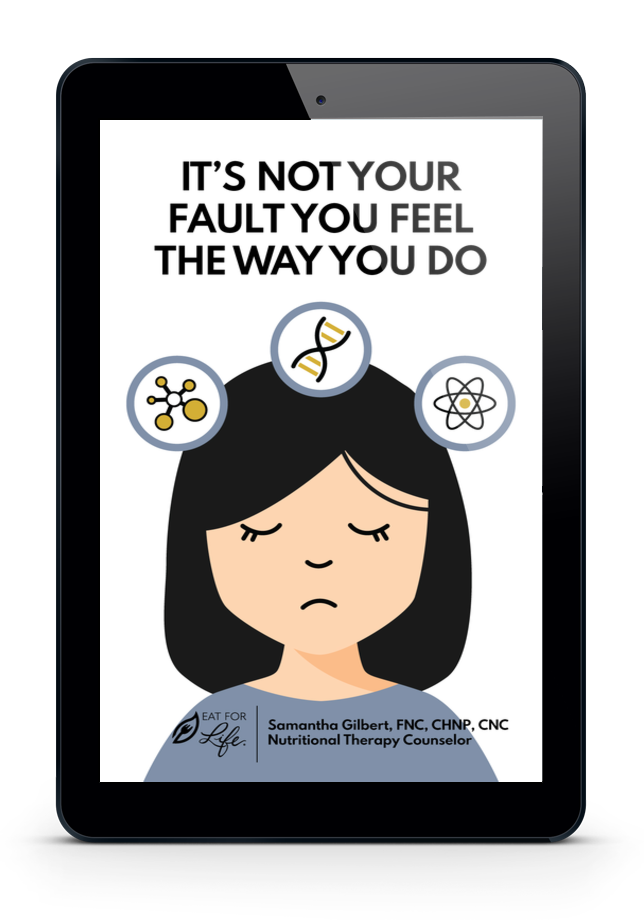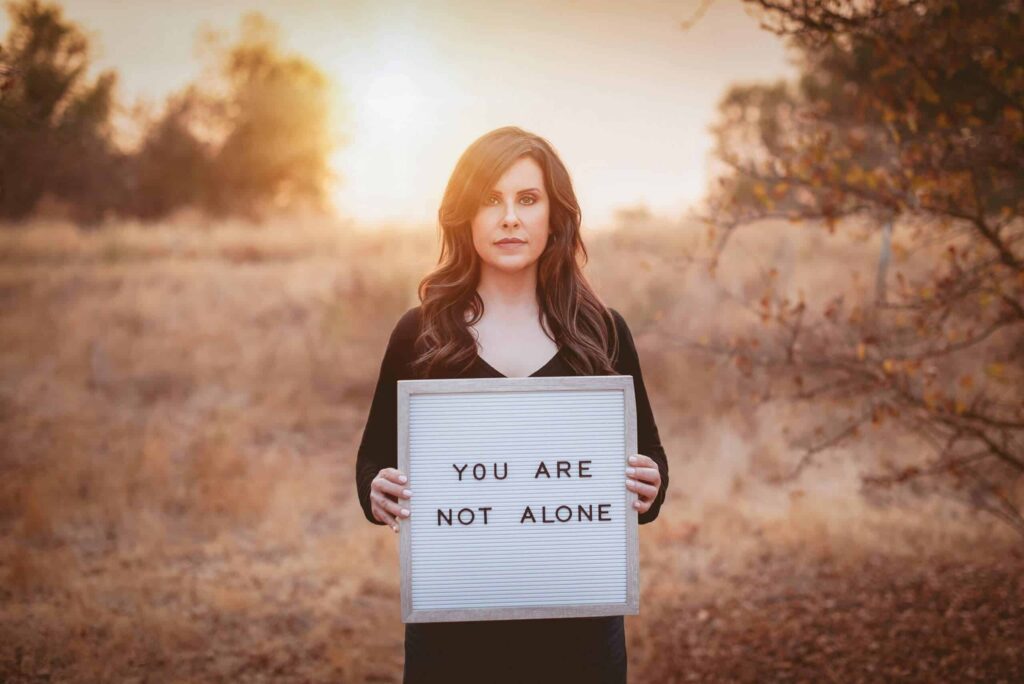Did you know that 80% of light pollution occurs at night, and over 35% of people experience sleep issues? Understanding the role that darkness deficiency and melatonin’s role in health and wellness is critically important.
In this episode, I talk with Dr. Catherine Darley, a naturopathic physician as well as the founder and director of the Institute of Naturopathic Sleep Medicine in Seattle, Washington, which is dedicated to patient care, public education about sleep health, and consultation with high-risk populations, such as first responders.
Dr. Darley is a leader in natural sleep medicine, combining her knowledge of sleep disorders with her training as a naturopathic physician to bridge these fields. Dr. Darley regularly writes articles and trains healthcare providers in the treatment of sleep disorders. She also co-authored the research study “Is Melatonin the “Next Vitamin D”? A Review of Emerging Science, Clinical Uses, Safety, and Dietary Supplements,” published last year in the journal Nutrients.
Find out how to combat the ubiquitous darkness deficiency of the digital age, and restore balance to your hormones.
In this episode, we discuss:
- How light pollution significantly impacts the circadian rhythm
- How there is actually more than one circadian rhythm
- How most people’s sleep habits are insufficient to promote normal physiology
- How exposure to artificial blue light affects hormone balance, specifically melatonin, and the many myths surrounding melatonin and its use as a powerful antioxidant
- Strategies for establishing a healthy circadian rhythm
Listen to the podcast here:
Links:
- The Institute of Naturopathic Sleep Medicine
- Is Melatonin the “Next Vitamin D”? A Review of Emerging Science, Clinical Uses, Safety, and Dietary Supplements
- Lux Light Meter Free app
- Herbatonin (create a free account to order)
- Melatonin Use in Children and Adolescents: American Academy of Sleep Medicine health advisory
- The End of Night: Searching for Natural Darkness in an Age of Artificial Light
- Download the Sleep Questionnaire
Within the below transcript, the bolded text is Samantha Gilbert, and the regular text is Dr. Catherine Darley.
___
What is Darkness Deficiency?
Most people are aware that sunlight is an essential component of health and are familiar with the term “sunlight deficiency.” Today, I’m excited to discuss “darkness deficiency” and how it affects long-term health outcomes.
What sparked your interest in studying melatonin and darkness deficiency?
We’re learning that melatonin goes beyond sleep. With people adopting electric light, 80% of the human population worldwide experiences light pollution at night, which has a role in suppressing our melatonin. I began to think about the connection between light at night suppressing our melatonin, and melatonin being needed throughout the body. Could that potentially be contributing to the great rise in chronic diseases that we’re seeing?
Many people have heard about the negative effects of using devices before bedtime. However, I believe that it has a much bigger impact than people realize, and they may not be taking it seriously or fully understanding its impact.
While I can provide resources, like links to blue-light blocking glasses, I agree with you that the issue is not taken seriously enough. We seem to be addicted to our devices.
I am curious about what you mean by “darkness deficiency.”

I define darkness deficiency as insufficient darkness to promote normal human physiology. To illustrate this, I like to remind people of the human experience before electric light. Although we don’t think about it often, we can intuitively understand how different it was from the modern experience. If you’ve gone camping, for instance, you know that just two nights of true darkness can improve your sleep.
Yes, and I often think about how much better I sleep when I visit friends who live in more rural areas without streetlights. Of course, I’m also engaging with my friends and enjoying myself, rather than being on my phone or computer like during a normal workday, which also contributes to my better sleep. But there is something to be said for being in nature and experiencing fresh air without all the modern conveniences. It’s tremendous, and I feel different when I wake up in the morning.
The Natural Circadian Rhythm
I’m curious about circadian rhythms and how they’ve been altered in modern times. What is the natural circadian rhythm?
We have the circadian rhythm at the brain level, which controls our melatonin, but we also have circadian rhythms at the tissue level and even at the cellular level. The cellular mechanisms are called peripheral clocks, and then the brain gives us our central clock. Circadian rhythms are 24-hour changes in function that we see throughout the body.
A basic one that we all have is sleeping at night and waking during the day, which is a 24-hour cycle. But then we have other cycles in our hormones that actually support melatonin being high at night and promote sleep. Cortisol is higher in the morning and promotes alertness and wakefulness. Insulin also has a circadian rhythm, as does thyroid hormone. All of these circadian rhythms help promote alertness and performance during the day, and then sleep and restoration processes at night.
Many of my clients and patients have dysregulated cortisol patterns.
We want our cortisol to follow a healthy, normal pattern. Cortisol should start to rise a couple of hours before we wake up, which helps us wake up and feel ready for our day. Then, it should be low in the evening, allowing drowsiness to set in. However, for people who aren’t getting the right light-dark signals, that cortisol rhythm can be affected.

How Artificial Blue Light Disrupts Circadian Rhythm
Let’s dive into what artificial blue light is and how it relates to humans and our ecosystem.
The light spectrum includes shorter wavelengths that are more blue in color and slightly longer wavelengths that are more red. Sunlight, of course, has wavelengths from UV to infrared, which is even broader than what we notice. Morning light is heavier in the blue wavelengths, and that color is what our eye’s system is sensitive to, which feeds back to the central pacemaker in the brain.
So in the morning, when we wake up, our melatonin is still somewhat elevated. But when we open our eyes, open the shades, go outside, we get this blue morning light on our retina, and it suppresses any melatonin that is still on board. Sunrise and sunset, of course, have more yellowish and reddish hues, and our eye and melatonin system are not as strongly suppressed by those colors and wavelengths.
The problem with artificial lighting is that it includes the blue spectrum, and it is also much brighter than sunset. It’s the wavelength and brightness of the light that makes a difference. The thing that’s really important for people to know is that over the last 20 years, as LED light bulbs have been developed, they have suppressed melatonin much more than incandescent bulbs. An incandescent bulb suppresses melatonin about 40%, while an LED bulb suppresses melatonin 80%. It’s significant, and while there are good environmental reasons for moving to LEDs, in terms of human health, it may not be such a good idea.
“Over the last 20 years, as LED light bulbs have been developed, they have suppressed melatonin much more than incandescent bulbs.”
There’s been a cascade effect of hormone imbalances, including thyroid, cortisol, and insulin. Our beautiful hormones have a perfect marriage and dance with one another, but we’re being blasted with things that we think will help the environment. While I’m not saying they won’t help, our efforts to be sustainable are backfiring on human health. Light at night even affects animal migratory patterns, as well as the patterns of deciduous tree leafing out, which change if there’s light at night in their environment. It’s interesting to consider the impact on the health of other living beings on Earth.

Understanding the Blue Light Cascade
How does exposure to artificial blue light affect other hormones, especially melatonin, on a deeper level?
Let’s first talk about normal human physiology. We have specialized cells in our eyes called intrinsically photosensitive retinal ganglion cells. They are located between our rods and cones and specifically measure the wavelength of light we receive. In the presence of blue light, they are especially sensitive and send a signal to the brain’s central pacemaker, the Suprachiasmatic Nucleus, indicating that it is daylight. The Suprachiasmatic Nucleus then sends a signal to the pineal gland, which produces melatonin.
Melatonin first goes into our brain and promotes drowsiness, then circulates throughout our body, signaling that it is nighttime and time for rest and restoration. Every cell in our body has melatonin receptors, and there are two main types. With artificial light at night, we may not receive the signal of darkness until we go to bed and turn off the lights. Even during sleep hours, people who keep night lights on or watch TV are not getting true darkness at night.
“People who keep night lights on or watch TV are not getting true darkness at night.”
It is important to note that if you can see your fingers wiggling when you hold your hand out at arm’s length, that is enough light to slightly suppress your melatonin. It is a very sensitive system. An expert panel released light and darkness recommendations for optimal sleep and circadian rhythm last year. Ideally, people should be in less than 10 lux of light for three hours before bed. One lux is the measure of one candle flame from three feet away, so 10 lux is 10 candles or less. Our homes are definitely more brightly lit than that.
For sleep, we want to be at less than one lux, which is very dim. You can download a free lux meter app on your phone and use your phone camera to measure light levels. It can be fun for families and individuals to measure light levels and try to achieve the recommendations.
There has been research comparing melatonin patterns in the built environment and in camping environments without electric light. The differences in melatonin patterns are quite profound. In the built environment, people’s melatonin pattern is shifted later and their melatonin release is shorter. The difference is particularly striking in the winter. In one study, melatonin release was 2.3 hours more in camping than in the built environment in winter. Melatonin has strong antioxidant and anti-inflammatory properties, which are important for aging. Missing optimal melatonin for two and a half hours a night in the built environment during winter means being in a more pro-inflammatory and pro-oxidative state than in historical light conditions.
“Melatonin has strong antioxidant and anti-inflammatory properties, which are important for aging.”
I want to say that I have the Lux app and love it. I’ve been using it for several years now and highly recommend it to my clients. Having it on your device can really help, but it’s best to be off devices for at least a couple of hours before sleeping.
Melatonin Supplements and Vitamin D
This discussion also reminds me of the similarities between melatonin and vitamin D, which we briefly touched on earlier.
We recently published a paper comparing melatonin and vitamin D. Vitamin D can be thought of as a hormone produced by sunlight, as it is produced in the skin when exposed to sunlight. On the other hand, melatonin is produced in the body when we are exposed to darkness. This is a fundamental comparison, as both compounds have actions throughout the body for every cell. Unfortunately, many people are deficient in both compounds. I think it’s essential to have both of them in our bodies.
Melatonin seems to have gotten a bad reputation over the years, and there are many safety concerns surrounding it. I’d love to hear your thoughts on this, especially as it relates to children.
So far, we have talked about our endogenous melatonin, which is naturally created, and the natural patterns that come with it. Now, let’s discuss melatonin supplements, which are quite popular. As you mentioned, they can be controversial.
One thing we see in the sleep and circadian literature is that there is not any evidence for using higher than three milligrams, and at the most for sleep and circadian rhythms. We want to stay within what is considered “physiological dosing,” which is up to one milligram. Those lower doses are well-established, as opposed to the higher doses.

I also think about the format. There was a new study just released a couple of days ago about melatonin in gummies. For children, gummies are a bad idea because they are so candy-like. What are we teaching our children?
“Take this candy before bed, it will help you.”
Also, people may not know that most melatonin is produced synthetically. It is manufactured in a factory. Therefore, it could potentially have contaminants of the solvents and whatnot that are needed in that chemical process. I like phyto-melatonin—melatonin from plants. Remember, plants and animals are all impacted by light at night, and this is true for melatonin as well. Plants and animals have melatonin. There is a phyto-melatonin, Herbatonin, that I like. I am on their medical expert panel. Herbatonin doesn’t have the potential for the solvents contaminating that the synthetic melatonin has.
We also want people to behave in a way that promotes sleep. The American Academy of Sleep Medicine recently published a health advisory that, especially for children, we first want to get all those lifestyle factors in place. For example, they should be in dim light and have time to mentally wind down right before getting into bed. All of those behavioral pieces should be in place, and then if melatonin is needed, it should be taken and given under a doctor’s or healthcare provider’s recommendation. It is a conundrum with all the conversation about melatonin because we do know that it is helpful, and we do know that people are suppressing their melatonin by all this artificial light.
Antioxidant and Anti-Aging Capacities of Melatonin
I’m also interested in the antioxidant capacities of melatonin. Specifically, I’m interested in its relation to cancer, Alzheimer’s disease, women’s hormones and infertility, PCOS, and MS.
Melatonin has a very strong antioxidant effect. In some rodent model studies, it’s been shown to be a more potent antioxidant than Vitamin C, Vitamin E, and glutathione, even—our go to antioxidants.
“Melatonin has a very strong antioxidant effect. In some rodent model studies, it’s been shown to be a more potent antioxidant than Vitamin C, Vitamin E, and glutathione, even—our go to antioxidants.”
As cells are doing their work, they produce what are called free radicals as kind of a byproduct of the chemical reactions in this at the cellular level. To counteract the damaging effects of free radicals, the body needs antioxidants to neutralize them. This is why it is important to consume foods that are high in antioxidants. As we age or when we are in a disease state, our bodies often produce more free radicals, making it essential to “PacMan” these harmful molecules with antioxidants to neutralize and remove them.
Melatonin supplements have been researched as a potential treatment for the different disorders discussed. However, there is still a limited amount of studies available, and more research is needed to determine the appropriate dosage and timing. Nonetheless, there are studies that suggest melatonin supplements may be beneficial for Alzheimer’s disease, cancer, infertility, PCOS, and as an adjunct therapy for COVID-19.
Additionally, melatonin has been compared to synthetic melatonin in terms of its antioxidant power. The results show that phyto-melatonin is several times more potent than synthetic melatonin. Also, when discussing the quality of supplements, it’s important to note that at least two studies have pulled melatonin supplements off the shelf and compared the actual content to what was listed on the label, and found significant variations. A new study on gummies that was released this week also found a significant variability in the actual compound compared to what was listed on the label.
I have seen practitioners promote the use of 150 milligrams as safe for long-term use, which has always concerned me.
What are the long-term outcomes of taking such a high dose as an anti-aging therapy? This question is particularly relevant in the context of phyto-melatonin, where we have a better source that the body can absorb and recognize compared to synthetic alternatives.
In the case of hormones, such as estradiol and progesterone, it’s essential to be cautious and mindful, particularly when dealing with melatonin as it is also a hormone. Therefore, I would put it in the category of needing to be safe and mindful. What are your thoughts on the use of 150 milligrams for anti-aging purposes?
150 milligrams is widely outside physiological ranges. I’m really a fan of physiological dosing. When I think about how we have this chronic lifetime for people who are using electrical light after sunset, which is most of us, we have kind of a chronic picture of melatonin suppression over our lifespan, missing hundreds of hours of natural melatonin release. And I think that supplementing at a physiological dose over a long period of time to counteract the negative effects of artificial light at night could actually be a good idea.
“Supplementing at a physiological dose over a long period of time to counteract the negative effects of artificial light at night could actually be a good idea.”
I am not aware of any research that has looked at a dosage of 150 milligrams of melatonin, either short-term or long-term. I am now curious to conduct specific research on that dosage. However, in all of the research that our team did for that paper, which looked at PCOS and melatonin, as well as Alzheimer’s and melatonin, there were no studies that came to mind that used such a high dosage.
One of the things that happens over the lifespan is that our melatonin levels are highest when we are preteens, and they decline rapidly in the teenage years. Then they decline again over the next few decades until we are left with about a third of the melatonin we had when we were younger by the time we are in our mid to late 40s. Therefore, I think about that age group and consider adding a low physiological dose of melatonin long-term to supplement their melatonin hormone back up to what it is in a younger person. I believe that would be a sensible approach.
Blue Light Blockers & Amber Lamps to Minimize Circadian Disruption
What do you typically recommend in regard to blue light blocking glasses for those with insomnia, as well as specific strategies and tips for establishing a healthy circadian rhythm?
I want to parse your question into two pieces. Let’s first talk about getting the proper light and darkness for circadian health. I love blue-blocking glasses, and I think putting them on two to three hours before bedtime is ideal.
Actually, when researchers look at modern cultures without electric light, they find that people go to sleep about 3.3 hours after sunset. So, create that environment for yourself by putting on blue blockers, ideally three hours before bed, or turning down the lights in your home and letting them create an atmosphere of sunset, which can be lovely. Instead of using electric lights, use candlelight or firelight if you have a fireplace. If you have to be on your devices, use flux or other types of apps to change the hue to a reddish-pinkish hue and mute it versus the bright white hue that computers typically have. Those practices are great.
“Create that environment for yourself by putting on blue blockers, ideally three hours before bed, or turning down the lights in your home and letting them create an atmosphere of sunset, which can be lovely.”
Also important, and I think people don’t necessarily know this, is to get 30 minutes of bright light as soon as possible in the morning. Our melatonin is still somewhat elevated in the morning, so suppressing it with bright light will help increase our nocturnal pulse of melatonin and make us feel sleepy at bedtime. One of the things we may be missing out on by suppressing our melatonin until we turn out the lights is that we don’t get to experience the sensation of increasing sleepiness, which makes us feel ready for sleep. Feeling sleepy when getting into bed is important for optimal sleep. If you don’t feel sleepy, there may be something that could be optimized.

Light is the main cue for our circadian central master clock in the brain. But we also get other inputs that are called Zeitgebers, or that’s a German word, it means “time cues.” Meal times should be regular, ideally starting breakfast within the same 30-minute window across all seven days of the week. Meal times, exercise times, times that you start your main activity, whether work or home tasks, school, and then wake time actually has a bigger impact on our circadian rhythm than bedtime. You want that to be standardized. I know it feels like a treat to sleep late on days off, but ideally, we want people to be getting up within the same hour across all seven days of the week.
Would installing and using lights with amber bulbs be helpful?
I think that’s a great strategy. I recommend having a “wind down” lamp in your home. At a certain time, you turn off all other lamps, and you have an amber bulb and a fairly dim bulb—ideally a Torchiere-style floor lamp—that’s aiming up at the ceiling and not shining the light right on your eyes.
“I know it feels like a treat to sleep late on days off, but ideally, you want to get up within the same hour across all seven days of the week.”
Establishing Nighttime Routines
Busy families have a lot going on, but doing these things together can create wonderful health outcomes for everyone.
In addition to having blackout curtains, I also wear an eye mask if there is any light peeking through the window. It really makes a big difference, and I always bring it with me when I travel. If you get a good one that has cushion and silk, it can be even more helpful and comfortable.
As for calming activities that families can do together, puzzles and reading together are great options. In America, families often eat together but then disperse to do homework or other activities. It’s understandable, but it’s also important to wind down together after dinner. Do you have any other thoughts on how families can do this together?
I love that idea because I think as parents, our role is to eventually help raise someone to be a healthy, happy, self-sufficient adult, right? And it’s a process. Having these healthy routines that they have learned at home is really terrific for long-term health. So doing things without the screen is ideal.
There are many ideas for spending quality time together. You can read paper books together, which can be great for snuggling, even for middle school kids. Lying on the sofa together and reading can also be lovely. Listening to an audiobook or some soft music can create a nice atmosphere. Taking a bath and playing music, like using a guitar and having people strum along, can be enjoyable. Hanging out with pets can also be a good option. Middle and high schoolers may not always want to hang out with their parents, but having a soothing pet to snuggle with before bed can be really lovely.

It’s important to give kids the opportunity to share and process their thoughts before bedtime. If you have a child who climbs into bed and starts calling out, “What about this?” or “This is what happened at school today,” it’s a sign that they haven’t had enough time during the day to reflect on their thoughts. Adults also experience this; they climb into bed and start processing their day. However, it’s better for everyone to learn that sleep time is not the time for processing thoughts. It’s important to intentionally set aside time earlier in the evening for this purpose.
As a mother myself, I’ve experienced my daughter getting into bed, even after a lovely evening, and then calling out with ideas, thoughts, and questions. And I realized, “Okay, we need to have a little bit more sitting in the armchair together and just talking about our day.”
I think a lot of this is lifestyle, and what you can do together as a family that is free and easy, and really helps create that calming feeling before getting under the sheets so that they can have a good night’s rest, and start their day in this rhythm.
I am more of a morning person. I’m typically in bed early by most people’s standards. I just love that routine, because it really makes a huge difference in how I feel—not only physically but mentally.
And I also work out in the morning.
Many people, however, work out in the evening, going to the gym fairly late because their rhythm is off. A lot of gyms are open 24 hours or until midnight, making it convenient. So, it is good practice to do less strenuous exercises and activities before bedtime. This will help calm down the nervous system and lead to a more peaceful state. This will also help reduce cortisol and other hormones that can disrupt sleep.
I have experience working with a condition called Pyrrole disorder. Many of my patients with this condition are night owls, experiencing increased energy at night. However, once we balance their zinc and B6 levels, which is important for sleep, we can often shift their sleep patterns. It’s important to recognize the role of biochemistry in sleep regulation, including melatonin and circadian rhythms.
As human beings, it’s common for us to read, watch, or listen to content that inspires us, but fail to act on it. I would include myself in this group. Therefore, I encourage people to try the lifestyle strategies we’ve discussed and commit to them for at least 10 days to see a real change. Try a 10-day experiment of following the light recommendations: less than 10 lux for three hours before bed, less than one lux during sleep hours, and 250 lux or more during the day, which is brighter than many indoor offices and schools.
To wind down and improve your sleep, consider taking a low physiological dose of melatonin, preferably a good quality one like Herbatonin. It’s also helpful to settle your thoughts and exercise before 4:00 pm, which shifts your body clock earlier. Exercising after 7:00 pm will make you more of a night owl. Starting your meals early in the day and getting 30 minutes of light in the first hour or two of your day can also help. Additionally, maintaining regular mealtimes is important. I encourage you to try the program full-on for the next 10 days and see what changes and improvements you experience. Based on your lived experience, you can decide whether this program adds to your quality of life or not.
I would also like to suggest keeping a journal. In today’s digital age, we rarely write things down with pen and paper anymore. Keeping a physical journal can help you track how this experiment is working for you and what you’re noticing. This will help you remember what is making a difference, such as having more energy when you exercise earlier in the day.
I believe sharing is caring, so I have a favor to ask. If my show is helpful to you, please share this podcast and consider leaving a review in Apple Podcasts. It is through sharing that we create community, eliminate guilt and shame, and bring about healing. Thank you in advance for taking three minutes out of your day to support my show so others can find me.






